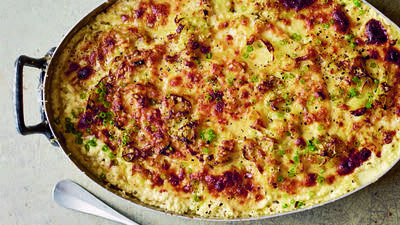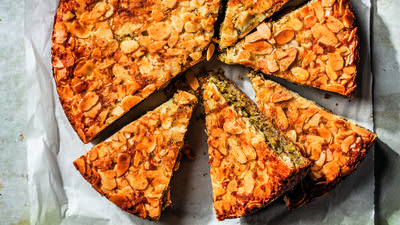
They say an apple a day keeps the doctor away. That depends on the type of apple -- some varieties are better for you than others.
Jo Robinson, author of Eating on the Wild Side, explains how to select foods that are full of healthy phytonutrients -- and how to preserve those nutrients while cooking.
Lynne Rossetto Kasper: You say something that's quite controversial in the book. You say the five-a-day -- we're told to have five servings of vegetables and fruit for nutrition -- is not doing the nutritional job.
 Jo Robinson (Frances Robinson)
Jo Robinson (Frances Robinson)
Jo Robinson: No, it certainly isn't, especially the fruits and vegetables that most people choose. The most common fruit is the banana, which is very low in different kinds of antioxidants; the Golden Delicious apple, again low in antioxidants; white potatoes; iceberg lettuce is the most popular lettuce. These are the foods that people will pick if you say five a day, and most people don't even get that five. We're really alarmingly deficient in these wonderful antioxidant compounds that can be in fruits and vegetables.
LRK: Antioxidants do what?
JR: They keep us alive.
LRK: That's basic.
JR: Yes. They're involved in every cell and system in your body, and they're defending us all the time against these noxious particles called free radicals that want to destroy cell membranes, wreck our DNA and give us cancer. We're bombarded with these free radicals, so we need to fight them with antioxidants. We truly wouldn't be alive without them.
LRK: From what I understand, antioxidants are part of this relatively new area in nutrition research called phytonutrients. Can you explain what phytonutrients are and why they're so special?
JR: Phytonutrients are basically a plant compound -- all plants produce them to protect themselves against their enemies. They can't run and hide, so they make these chemicals that will ward off insects and browsers and protect them from ultraviolet (UV) light. If we eat them, then we absorb those particles, phytonutrients, and they protect us from our enemies, which happen to be cancer, cardiovascular disease, Alzheimer’s, diabetes and obesity. Their protection becomes our protection.
LRK: Your premise in the book is that over thousands of years of agriculture, many of the phytonutrients have been bred out of the plants, right?
JR: Exactly. I got this information from more than 6,000 studies, and the accumulating evidence is really alarming. A typical fruit or vegetable might have from 1/2 to 1/100 of the phytonutrients of wild plants, which we lived on for much of our evolution. Unwittingly, starting 10,000 years ago, we started choosing plants to grow that were higher in sugar, higher in starch and lower in these phytonutrients. That trend continues today.
LRK: If we decide to eat heirloom or organic, is that going to give us the phytonutrients -- or at least some of the phytonutrients -- that have been bred out of our food?
 Eating on the Wild Side
Eating on the Wild Side
JR: Yes. A number of studies show that organic production increases phytonutrients a small amount. Not every study shows this, but some do.
Some heirlooms have many more phytonutrients than the ones in the grocery store, but not all of them. The Golden Delicious apple is a 100-year-old heirloom. It is so low in phytonutrients and high in sugar that it can increase your triglycerides, these bad blood fats that are linked with heart attack and stroke, and your low-density lipoprotein cholesterol. Not all heirlooms are nutritious for us.
LRK: The big question is: What is out there that we should be eating? Obviously this is not just a case of eat more apples; it’s a case of eat more of the right apples.
JR: Exactly. One of the exciting things about my work is that I have found fruits and vegetables that are in every grocery store that are actually the equivalent of wild plants. They're not almost as nutritious as wild plants; they're actually as nutritious.
You can just go to a grocery store and if you were to buy green onions, they have 100 times more phytonutrients than other onions in the store. They're inexpensive, they're common and they're unheralded super foods. It's the green portions that are the best for you; when you're chopping them up, make sure you chop up all the green portions too. Kale; black, red and dark red grapes; artichokes; parsley; all of the herbs -- they're just like eating wild plants.
Just as important in every kind of fruit and vegetable, there are some that are much more nutritious than others. Let's talk about apples. The Golden Delicious is at the bottom of the ranking and Granny Smith is at the top. There are other nutritious ones like Fujis, the old Red Delicious, Braeburns and Galas. They're much more nutritious than Golden Delicious, Elstar, Empire or Pink Lady. If you know which ones to choose, an apple a day can keep the doctor away.
LRK: What about lettuces?
JR: The lettuce that we eat in the greatest quantity is iceberg lettuce, and it is the least nutritious. Those inner leaves have so few phytonutrients because they don't have to protect themselves from the sun. They're all closed up, so they're not making phytonutrients as protection. When we eat them, we don't get it.
What we want to find is lettuce that has an open structure so that all the leaves are fanned out and exposed to the UV light, so they have to produce phytonutrients. Leafy lettuces are much better for us than the head lettuces. In the leafy lettuces, the one that are red-tinged, have the brown-green color or are all red are the best of all.
LRK: How about blueberries? This is a fruit now that everybody is talking about how nutritious it is for you.
JR: It is, and we need to eat a lot more berries. On average, we eat two tablespoons of berries a week.
LRK: That's not very much.
JR: It's trivial, and some of it's in those Pop-Tarts. Berries are excellent for us, including blueberries, but I recommend that you eat 1/2 cup a day. There are some blueberries that are better for us than others; if you go to a you-pick farm, you can find these extra-nutritious blueberries. In the grocery store you can find frozen wild blueberries -- they're two or three times richer in these protective compounds than the fresh blueberries that we see.
LRK: You also mentioned something about how you're supposed to defrost those berries, which I found intriguing.
JR: Yes. There are so many things that I read that I had a hard time believing. Now that we know about these phytonutrients and that they're important for our health, the kitchen scientists are finding ways to preserve them in our food. It turns out that if you thaw frozen berries in the refrigerator or on a counter, you lose about half of the phytonutrients.
But if you defrost the blueberries in a microwave, you don't lose them. It's a really fast thaw that protects the phytonutrients and gives us these great anthocyanins, which are good for our cognition and memory and fight cancer and cardiovascular disease. There are these kitchen tricks that I write about that really can be instrumental in bringing back these lost nutrients.
LRK: Generally in cooking vegetables, is it better to cook them in the microwave, steam them or stir-fry them?
JR: All of those are good choices. What you don't want to do is put them in boiling water because the nutrients that dissolve in water as that food cooks, the cells break down and those nutrients leak into the water. If you were to boil spinach, for example, which most people do, you're going to have more phytonutrients in the water than in the vegetable.
Stir-fry is good because it’s not a liquid that the food is cooking in, so those water-soluble nutrients don't get into the oil. If you use an extra virgin olive oil, the food becomes more nutritious because it absorbs some phytonutrients from that excellent olive oil.
LRK: I have to ask you about the garlic trick, because garlic we know is very nutritious.
JR: This is an example of the kind of research that's in these dense, academic journals that nobody is bringing out and telling consumers about -- that's what I see as my job.
Here's the problem: If you take garlic and you chop it, dice it, and immediately fry it or put it in hot foods, it doesn't produce the nutritious compounds that are so protective called allicin. If you expose it to heat right away, it doesn't produce allicin and we don't get that protection. We get the flavor, but we don't get protection against cancer, which is one of the primary health reasons to eat garlic.
There's a trick: If you just chop, dice, slice or press that garlic, set it aside for 10 minutes before you expose it to heat. That garlic is producing all that allicin. When that reaction is complete, you can do whatever you want to it at that point. You can broil it, you can fry it and you get all of the allicin. It's just press, rest for 10 minutes.
LRK: Do pesticides and fertilizers affect nutrients?
JR: Surprisingly they do. Let's look at pesticides. What they do is protect plants from insects and other diseases and problems that would attack those fruits and vegetables. We want them to be perfect-looking -- we don't want any blemishes.
But that plant is so protected that it doesn't have to make any phytonutrients to protect itself. It's lower in phytonutrients because we've coddled it. We coddle all of our fruits and vegetables and unwittingly reduce their phytonutrient content and their health benefits for us.
Before you go...
Each week, The Splendid Table brings you stories that expand your world view, inspire you to try something new, and show how food connects us all. We rely on your generous support. For as little as $5 a month, you can have a lasting impact on The Splendid Table. And, when you donate, you’ll join a community of like-minded individuals who love good food, good conversation, and kitchen companionship. Show your love for The Splendid Table with a gift today.
Thank you for your support.
Donate today for as little as $5.00 a month. Your gift only takes a few minutes and has a lasting impact on The Splendid Table and you'll be welcomed into The Splendid Table Co-op.




